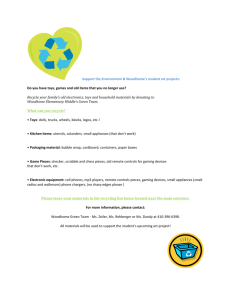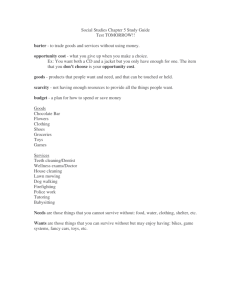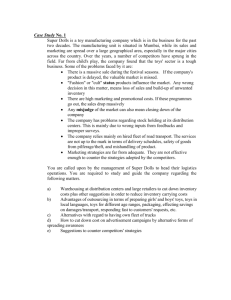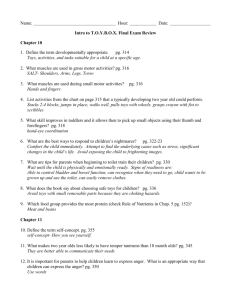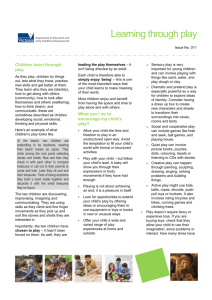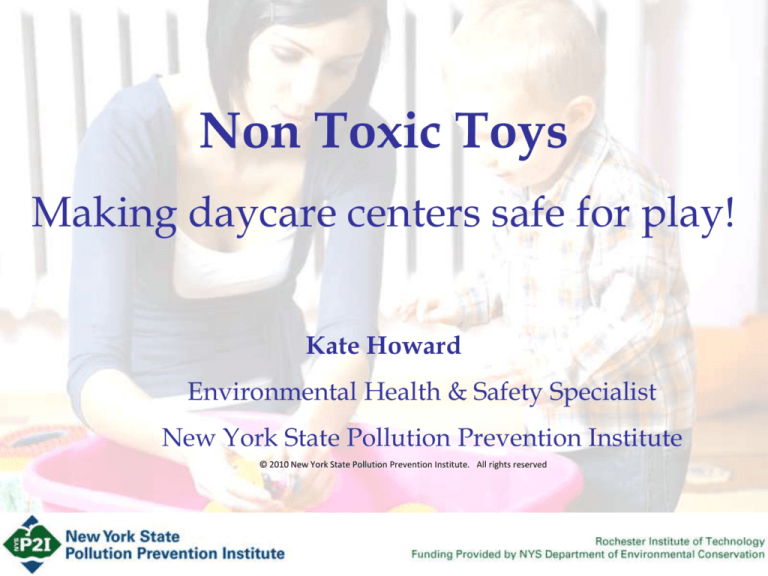
Non Toxic Toys
Making daycare centers safe for play!
Kate Howard
Environmental Health & Safety Specialist
New York State Pollution Prevention Institute
© 2010 New York State Pollution Prevention Institute. All rights reserved
Focus
• How toxic chemicals affect children
• Hot topic: Phthlates and bisphenol A
• Toxics found in toys and their effect on the
environment
• Recall and testing information sources
• Consumer Product Safety Improvement Act
Children’s Vulnerability
Children are at higher risk of suffering effects
1. Children have greater pound-forpound intake of air, water, and food
2. Hand to mouth behavior
3. Greater portion of time spent close to
the ground
4. Their bodies are growing and
developing. Development can be
interrupted by exposure to toxins and
cause lower IQ, hormone-dependent
cancer, asthma, or other health
problems
Product Safety
• Companies do not have to disclose to
consumers what is in their products
• Consumer Product Safety Commission
– Charged with protecting the public from
unreasonable risk from consumer products
– Protect from products that pose fire,
electrical, chemical, or mechanical hazard
or can harm children
– Operates voluntary recall program
• CPSC can’t test toys before sale to
ensure they are safe
Consumer Product Safety Improvement Act
• Enacted Jan08
• Goal to protect children from lead and phthalate hazards by
– Reducing lead limit
– Establishing phthalate limit
– Requiring product testing to ensure products meet limits
• Guidance & changes
– Jan08: resellers do not need to certify products against lead and
phthalate requirements
– Jan30: one year extension for testing of certain products
• Articles must meet the lead & phthalate limits, but manufacturers do not
need to test products to verify they meet the requirements
• First major deadline passed Feb10
– Lead limit reduced to 600ppm
– Limit for certain phthalates set to 0.1% (100ppm)
CPSIA (continued)
1. Lead paint ban strengthened
1977 limit of 600ppm down to 90ppm by Aug09
2. Lead in children’s products is a banned hazardous substance
600ppm Feb09
300ppm Aug09
100ppm Aug11
3. Ban on phthalates in toys & children’s products
Products with DEHP, DBP, BBP higher than 0.1% are permanently
banned Feb09
Products children can put in their mouth with DINP, DnOP, & DIDP
higher than 0.1% are provisionally banned Feb09
4. CPSC significant funding & staff increases
5. Increased penalties
Toxics that have been found in Toys
1. Plastics
2. Metals
3. Wood
4. Fabrics
Plastics
Soft, squishy, mouthed
Hard, shatter proof
PVC and Soft Plastic
Phthalates - group of chemicals commonly used as softener
Soft toys typically contain 15-20% phthalates
New shower curtain smell
Not bound to plastic so they can leach out
Children are at especially high risk as they mouth toys
Health effects are very controversial
Actions you can take
Avoid plastic with #3 or PVC
identification
Avoid toys labeled “vinyl”
Avoid soft plastic toys when possible
Choose products labeled “phthalate
free”
Call toll free number on product to
contact manufacturer and ask about
presence of PVC
Phthalates Controversy
In animals they have been shown to cause
Damage to reproductive and endocrine
systems
Liver and kidney abnormalities
Premature birth
Reproductive defects
Early onset of puberty in girls
Harm reproductive system of males
Expected – but not yet proven –
to cause same effects in humans
No documented human illness due to
phthalate exposure
Mouthing behavior creates unique risk for
children
Toy industry say phthalates in toys do not
put children at risk as the exposure is too
low to do damage
European Union and California banned 6
phthalates from children’s products
CPSIA limits levels of certain phthalates in
children’s toys & articles
Decision to avoid phthalates is
precautionary
Lead, cadmium, mercury, arsenic are common PVC
stabilizers
What happens to PVC?
Dioxin is a carcinogen and hormone disruptor. It bioaccumulates and takes a
long time to degrade, remaining in the air, water, and soil.
Incineration
Dioxin, phthalates, and heavy metals
are emitted
Phthalates cause developmental and reproductive damage, altered liver and
kidney function, and are linked to the development of respiratory problems in
children.
Hydrochloric acid damages pollution
control equipment and reacts with
other additives to create toxic fumes
Heavy Metals build up and do not degrade in the environment. Small
concentrations are needed to sustain life, but larger concentrations can impair
mental and neurological function.
Ash has concentrated levels of dioxin
and heavy metals that must be
landfilled
Hydrochloric Acid creates toxic fumes and damages pollution control
equipment during incineration. Long-term exposure to low levels can cause
respiratory problems, eye and skin irritation, and discoloration of the teeth.
Bisphenol A causes hormone disruption and is linked to early puberty, breast
cancer, prostate disease and cancer, and brain damage.
Vinyl Chloride causes damage to the liver, lungs, blood, nervous system,
immune system, cardiovascular system, skin, bones and reproductive system.
Landfill
Does not biodegrade, but
additives leach out of the
plastic
Phthalates, dioxin, bisphenol
A, vinyl chloride, and heavy
metals leach into the soil and
groundwater
Accidental fires release dioxin
into the environment
Recycle
Very low recycling rate
Hydrochloric acid is generated
Contaminates recycling of other plastics
Poor quality of recycled goods
Cannot be blended with virgin PVC
PVC-Free Manufacturers
A-One
Ambitoys
Ampa Hispania
APRICA Kassai
Artbaby
Babelito
Bandai
Big Toys (playgrounds)
Brio
Bullyland Toys
Chicco
Continua
Early Start
Fashy
First Years
Giochi Perziosi
Grazioli
Juguetes y Herrajes Joal
Kiko International
Lamaze Infant Development
Lego Group
Little Tykes
Mapa
McDonalds
Novatex
People Co.
Pilot Ink
Play by Play
Playmobil
Ravensburger
Sassy Products
Tiny Love
Toho
Tomy
Young Epoch
• Toys R Us began phasing out PVC in its branded products and announced in
January 2009 all products sold in Toys R Us & Babies R Us will not have
phthalates
• Comprehensive list of manufacturers eliminating PVC use at
http://www.besafenet.com/pvc/companypolicies.htm
Polycarbonate & BPA
Bisphenol-A – found in some polycarbonate
shatter resistant plastics
Baby bottles, metal can linings, sippy
cups, food storage
Water soluble
Heating a container increases BPA
leaching into liquid
Endocrine disruptor
Linked to down’s syndrome, obesity,
hyperactivity, breast & prostate
cancer
Causes breast cancer, testicular
cancer, and diabetes in laboratory
animals at low doses
Canada banned baby bottles with BPA
Toxic to aquatic environment
Actions you can take
Avoid plastic with #7, OTHER, or PC
identification for storing foods and drinks
Avoid heating drinks or food in PC plastic
Avoid using strong cleaners on PC containers as
they release BPA from the plastic
Choose products labeled “BPA free”
Call toll free number on product to contact
manufacturer and ask about presence of BPA
BPA Free Products
For more info, go to www.bisphenolafree.org
Metals
Lead
Found in: PVC, paint of old wood and metal toys
(imports and metal soldiers)
Health & environmental effects: neurotoxin, learning
disabilities, behavior disorders, low exposures have
lifelong effects, bioaccumulative
Cadmium
Found in: PVC
Health & environmental effects: known carcinogen and
kidney toxin, bioaccumulative, animals suffer similar
effects as humans
Mercury – banned from novelty products
Found in: batteries
Health & environmental effects: nerve, brain, and
kidney damage; learning disabilities; converts to methyl
mercury in the environment which accumulates in fish
and other organisms
HealthyToys.org
Tested 1,528 toys for lead, cadmium, chlorine,
arsenic, bromine, mercury, chromium, tin
and antimony
Lead detected in 20%
• American Academy of Pediatrics
recommend 40ppm as safe lead level
• Federal recall standard is 600ppm
• 3.5% lead level above 600ppm
• Jewelry 5x more likely to have 600ppm or
greater lead concentration
Highest lead levels:
• 8,000-190,000ppm in 4 sets of holiday
jewelry
• 4,113ppm in children’s sandals
• 2,446ppm in a set of blocks
Heavy Metals
Wood
• 80% of forests have been destroyed or
degraded due to clear cutting for lumber
& paper
• Heavy metals often used in paints
• Plywood and particleboard can contain
formaldehyde
– Offgasses from the wood
– Short term: irritate eyes, skin, and
throat; cause nausea and lethargy
– Over the long term it can cause
cancer
– Look for: pressed wood at edge of
toys and puzzle pieces
– Pressure treated wood play sets can
contain arsenic
Actions you can take
Avoid old painted toys as the paint may contain
lead
Avoid those not made in the US, Canada, or
Europe where standards aren’t strictly enforced
Choose solid wood with nontoxic paints and
finishes – linseed & walnut oils & beeswax are
best
Choose wood certified by the FSC or SFI
Look for toys made out of recycled wood
Pressed Wood & Plywood
Cotton, Wool, and Other Fabrics
• Traditionally use heavy amounts of
herbicides, insecticides, and fertilizers
• Cotton production uses ¼ of the
world’s insecticides
• Heavily pollute the groundwater
• Azo dyes can be carcinogenic, toxic,
and eco-toxic – usually in products that
come from eastern Asia
• Most are stain and moth proof – Teflon
and Scotchguard
– Perfluorinated compounds: toxic &
persistent
• Brominated flame retardants are
commonly used
– Persistent & bioaccumulative
– Impair attention, learning, memory and
behavior in lab animals
Actions you can take
Avoid azo dyes
Avoid moth, stain, and fire proof fabrics
Choose organic, untreated cotton and wool
Choose nontoxic colorfast dyes
Choose wool for its natural fire resistance
Look for fleece dolls and stuffed animals made
out of recycled materials
Brominated Flame Retardants
Road Racers with Play Mat
By Fun Club
Princess Jewelry
By Dollar Tree
Lightning McQueen Racing Chair
By Disney
Mat: Bromine 30,831ppm
Necklace: Lead 257ppm
Bromine 12,550 ppm
Chlorine/PVC 257,196 ppm
Seat: Bromine 14,905
Mercury 39ppm
Hair Clip:
Lead 57ppm
Bromine 25ppm
Base: Lead 34ppm
Bromine 25,562ppm
Mercury 156ppm
Information Sources
Product Testing: Healthy Toys www.healthytoys.org
Product Recalls: CPSC www.cpsc.gov & Recalls.gov www.recalls.gov
Washington State Toxics Coalition
Safe Start for Kids http://www.watoxics.org/safer-products/safe-start-for-kids
Toxic Free Toys Campaign http://www.watoxics.org/issues/saferproducts
Environment California Stop Toxic Toys
http://www.environmentcalifornia.org/environmental-health/stop-toxic-toys
Healthy Child Healthy World http://healthychild.org
US PIRG (Public Interest Research Group) www.uspirg.org/issues/toy-safety
Environmental Working Group www.ewg.org
Healthy Toys.org
• Tests sample of toys & children’s articles every year
• Results released each fall
Lead
Found in: jewelry, paint, PVC
Concern: neurotoxicity
Mercury
Found in: inks, adhesives
Concern: persistent, toxic, kidney damage
Cadmium
Found in: PVC, coatings, pigments in plastic & paint
Concern: developmental effects, known carcinogen
Chromium
Found in: stainless steel, pigments
Concern: some are known carcinogens, cause birth
defects and reproductive problems
Chlorine
Found in: vinyl (soft plastic)
Concern: phthalate additives are endocrine disruptors
Arsenic
Found in: dye in textiles & plastics
Concern: known carcinogen, kidney damage
Bromine
Found in: flame retardants in textiles & electronics
Concern: persistent and toxic, possible carcinogen
Tin
Found in: PVC
Concern: organotins are toxic at low exposure,
several cause nervous system damage
Antimony
Found in: flame retardant, polyester
Concern: weakly mimics estrogen
CPSC Voluntary Product Recalls
Categories
1. Child products (not
including toys)
2. Toys
3. Household products
4. Outdoor products
5. Sports & recreation
products
6. Specialty products
WA Toxics Coalition - Safe Start for Kids
Provide guidelines for
choosing safer products
– Arts & craft supplies
– Baby bottles, sippy
cups, pacifiers
– Clothing & apparel
– Furniture
– Lunchboxes and
storage
– Mattresses and
changing pads
– Personal care products
– Toys
– Tableware
Quick Tips Buying Guidelines
Choose
Avoid
Products made from natural materials
Products labeled “phthalate free” and
“BPA free”
Made in the USA, Japan, Canada or
Europe
Solid wood instead of pressed wood
with nontoxic paints and finishes
Wood certified by FSC or SFI
Organic and untreated cotton, hemp,
wool
Brands that have committed to using
environmentally friendly or sustainable
materials
Call toll free number on product to
contact manufacturer and ask about
presence of PVC and/or BPA
Cheap metal jewelry due to lead
content
Old painted toys as the paint may
contain lead
Permanent markers and paints
Pressed or layered wood due to toxic
glue
Lights and sounds due to small batteries
with mercury
Play cosmetics as they often contain
heavy metals
Plastic labeled vinyl, #3, or PVC as it
typically contains lead and phthalates
Plastic with #7, OTHER, or PC
identification for storing foods and
drinks
Moth, stain, and fire proof fabrics
Questions?
Kate Howard
New York State Pollution Prevention Institute
Rochester Institute of Technology
p: 475-5390
f: 475-5455
e: kmhasp@rit.edu
www.nysp2i.rit.edu




